Cruising is often seen as the perfect getaway, filled with exciting activities and opportunities for relaxation. It is usually seen as a safe way of traveling, though you still may have wondered: How many cruise ships have sunk?
How Many Cruise Ships Have Sunk?
In the past 100 years, approximately 24 cruise ships have sunk. The causes and impacts of these incidents vary, including wartime activities, accidents, and severe weather conditions. In some cases, ships sank only while being towed.
In modern times, cruise ships rarely sink, thanks to strict safety rules, ship stabilizers, modern technology to help avoid rough seas, and regular practice drills for emergencies. These advancements have significantly improved the safety and reliability of cruise travel, making incidents of sinking exceedingly rare.
Cruise lines have implemented numerous precautions to enhance passenger safety. Advanced weather tracking systems, improved life-saving equipment, and rigorous safety protocols are now standard. Continuous crew training in emergency response and evacuation procedures further ensures that cruising remains one of the safest forms of travel.
But, there have still been some cases where cruise ships have gone down due to bad weather, mistakes by people, or problems with the ship itself.
In this article, we’re going to look at these rare events, talking about how many cruise ships have sunk, what led to these sad moments, and how they’ve helped make cruise ships safer today.
List of Cruise Ships That Have Sunk Throughout History
Here is a list of cruise ships that have sunk throughout history, including ocean liners, as they are considered early versions of modern cruise ships. The list is organized chronologically, from the earliest to the most recent sinkings.
Titanic (1912)
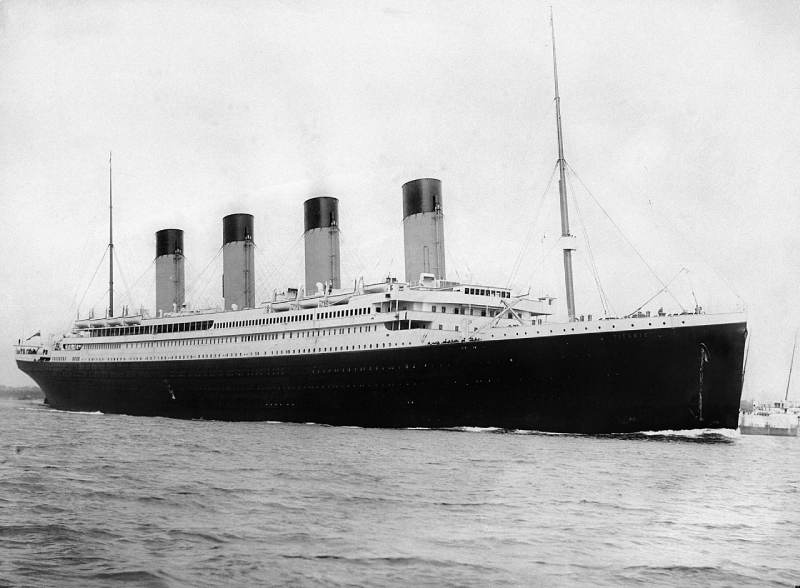
Although not technically a cruise ship in the modern sense, the Titanic was designed to be the largest and most luxurious ship of its time, a hallmark of today’s cruise ships. Its April 1912 inaugural voyage ended in tragedy, and it is now one of the most renowned maritime disasters in history.
On the night of April 14, 1912, four days into its journey from Southampton to New York City, the Titanic struck an iceberg in the North Atlantic Ocean. The collision caused the ship’s hull plates to buckle inwards along its starboard side and opened five of its sixteen watertight compartments to the ocean. Despite being touted as “unsinkable”, the Titanic was fatally damaged. The ship’s design allowed it to stay afloat if two compartments were flooded, but not more. As water spilled from one compartment into the next, the fate of the Titanic was sealed.
The sinking of the Titanic was a horrifying event, marked by acts of heroism and tragic loss. Of the estimated 2,224 passengers and crew aboard, more than 1,500 lost their lives, making it one of the deadliest peacetime maritime disasters in history. The ship also didn’t have enough lifeboats, which made the situation much worse.
The aftermath of the Titanic disaster led to many changes in maritime safety practices. The International Convention for the Safety of Life at Sea (SOLAS) was formed in 1914 to ensure that ships would be equipped with adequate lifeboat space for everyone on board, among other safety measures.
Sinking date: April 14, 1912
Deaths: 1,517
Survivors: 705
Maiden voyage: April 10, 1912
Length: 883 ft. (269 m)
Original capacity: 2,453 passengers
RMS Empress of Ireland (1914)
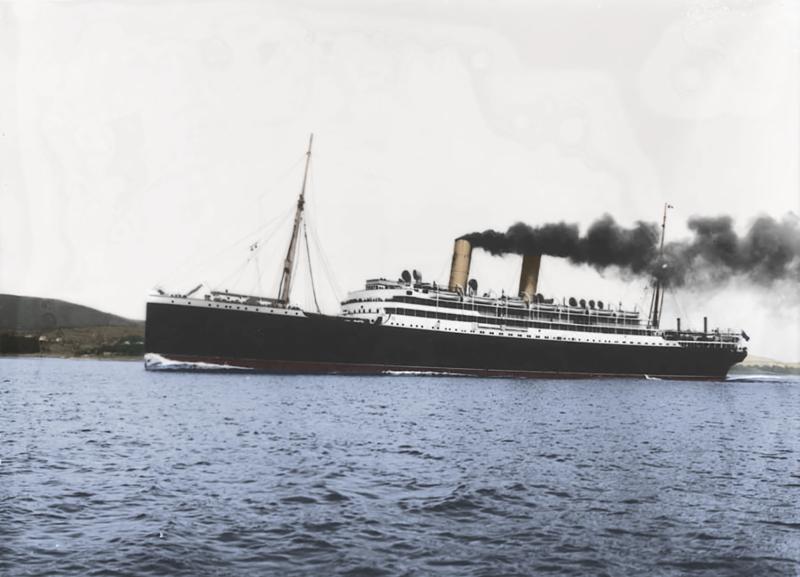
The sinking of the RMS Empress of Ireland is one of the most tragic maritime disasters in history. On May 29, 1914, the Empress of Ireland, a Canadian Pacific steamship, collided with the Norwegian collier SS Storstad in the Saint Lawrence River, near Pointe-au-Père, Quebec, Canada. The Empress was on her 96th transatlantic voyage, heading from Quebec City to Liverpool, England, with 1,477 passengers and crew aboard.
The collision occurred in the early hours, under a thick fog. The Storstad, carrying a load of coal, struck the Empress of Ireland on her starboard side, causing a gaping hole. The impact was devastating; the Empress began to sink rapidly, making many of the lifeboats unusable. Panic ensued as passengers and crew scrambled to escape the rapidly sinking ship. In less than 15 minutes, the Empress of Ireland sank into the cold waters of the Saint Lawrence River, claiming the lives of 1,012 people. Only 465 people survived the disaster.
Sinking date: May 29, 1914
Deaths: 1,012
Survivors: 465
Maiden voyage: June 29, 1906
Length: 574 ft. (175 m)
Original capacity: 1,542 passengers
RMS Lusitania (1915)

The RMS Lusitania was a British ocean liner and one of the world’s largest and fastest passenger ships at the time. During World War I, on May 7, 1915, it was sunk by a German U-boat (submarine) off the southern coast of Ireland.
The Lusitania was en route from New York City to Liverpool, England, carrying 1,959 passengers and crew, along with a significant amount of cargo. Despite warnings from the German Embassy, the Lusitania set sail on what would be its final voyage.
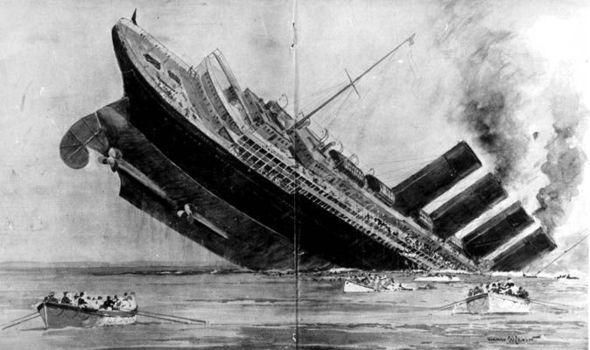
On the afternoon of May 7, the German U-boat U-20 fired a single torpedo at the Lusitania, which struck the starboard side of the ship. The explosion and a second internal explosion caused the Lusitania to sink in just 18 minutes, resulting in the deaths of 1,198 passengers and crew.
The sinking of the Lusitania caused an international outcry, particularly in the United States, where 128 American citizens were among the dead. The German government justified the attack by alleging that the Lusitania was carrying munitions and other contraband, making it a legitimate military target. This claim was partly substantiated.
Sinking date: May 7, 1915
Deaths: 1,197
Survivors: 761
Maiden voyage: September 13, 1907
Length: 787 ft. (240 m)
Original capacity: 2,198 passengers
HMHS Britannic (1916)
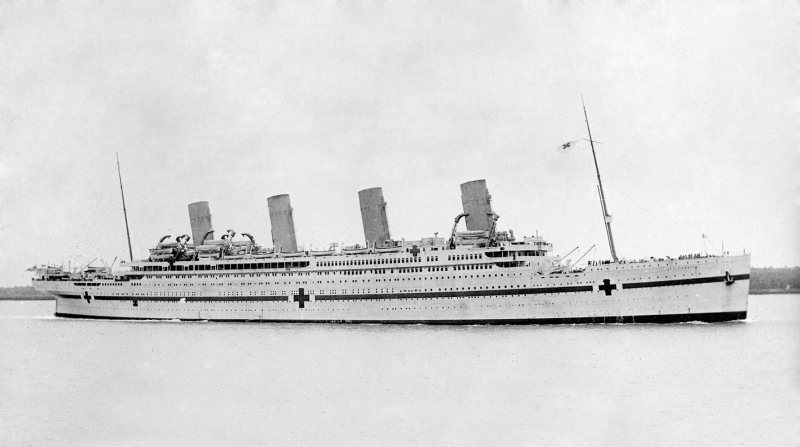
The HMHS Britannic, the third and largest of the Olympic-class ocean liners, was a sister ship of the RMS Titanic and RMS Olympic. Designed with luxury and safety in mind, the Britannic was launched just before the outbreak of World War I and was used as a hospital ship during World War I. It was on a mission to transport wounded soldiers from the Middle East back to Britain when it sank.
On the morning of November 21, 1916, while navigating through the Aegean Sea, near Greece, the Britannic struck a mine believed to have been laid by the German submarine U-73. The explosion caused severe damage to the starboard side of the ship. The Britannic began to flood rapidly and sank within 55 minutes of the explosion.

The evacuation was chaotic. Lifeboats were launched prematurely by panicked crew members, and some were sucked into the ship’s propellers, resulting in many casualties. Despite this, the majority of the 1,066 people on board were saved.
Today, the Britannic remains on its side at the bottom of the Aegean Sea. The wreck was discovered in 1975 by Jacques Cousteau and has since been explored by numerous expeditions. The sinking of the Britannic, while not as well known as the Titanic disaster, remains one of the greatest maritime tragedies of World War I.
Sinking date: November 21, 1916
Deaths: 30
Survivors: 1,036
Maiden voyage: December 23, 1915
Length: 882 ft. (269 m)
Original capacity: 489 passengers
MS Georges Philippar (1932)

The MS Georges Philippar was a French ocean liner named after Georges Philippar, a prominent figure in the French shipping industry. The ship was part of the fleet of Messageries Maritimes, a major French shipping company. Its design was cutting-edge for the time, featuring luxurious accommodations and advanced safety features.
On its maiden voyage from Marseille to the Far East, tragedy struck in the Gulf of Aden, near the coast of Yemen. During the night, a fire broke out onboard, quickly spreading through the ship. Despite the crew’s efforts to contain it, the fire overwhelmed the ship’s safety measures. The passengers and crew faced a chaotic and desperate situation as the flames engulfed the liner.
The disaster led to significant loss of life, with many passengers and crew members perishing in the fire or drowning after abandoning ship. Investigations into the sinking of the MS Georges Philippar focused on the cause of the fire, which was believed to have started in a cargo hold, possibly due to improper storage of flammable materials.
Sinking date: May 16, 1932
Deaths: 41
Maiden voyage: May 16, 1932
Length: 543 ft. (165 m)
Original capacity: 1,000+
SS Morro Castle (1934)
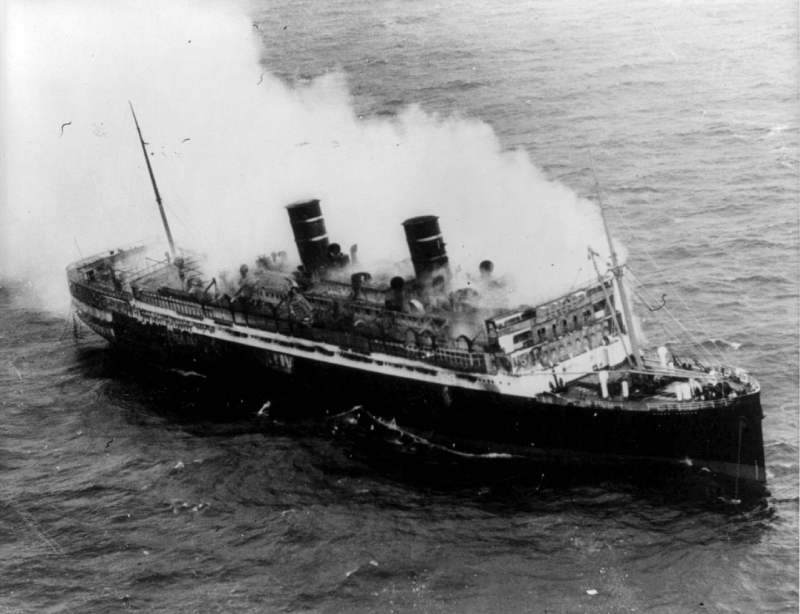
The SS Morro Castle was an American ocean liner that sank on September 8, 1934. The ship, which was named after the Morro Castle fortress that guards the entrance to Havana harbor, was en route from Havana, Cuba, to New York City when it caught fire and burned. This led to the deaths of 137 passengers and crew members out of the 549 people on board.
The fire began in the early hours of the morning under mysterious circumstances. The ship’s highly flammable materials helped the fire spread. The disaster was worsened by a lack of leadership following the death of the ship’s captain, Robert Wilmott, from an apparent heart attack the day before the fire. This left the crew without clear command and coordination, contributing to the chaotic evacuation and rescue efforts.
As the Morro Castle burned, it drifted closer to the shore, eventually grounding itself near Asbury Park, New Jersey. On March 14, 1935, the ship was being towed to a scrapyard when it supposedly sank and was then refloated. Though it is disputed whether or not it really sank.
Sinking date: March 14, 1935 (disputed)
Deaths: 137
Survivors: 412
Maiden voyage: August 23, 1930
Length: 479 ft. (146 m)
Original capacity: 3
RMS Empress of Britain (1940)
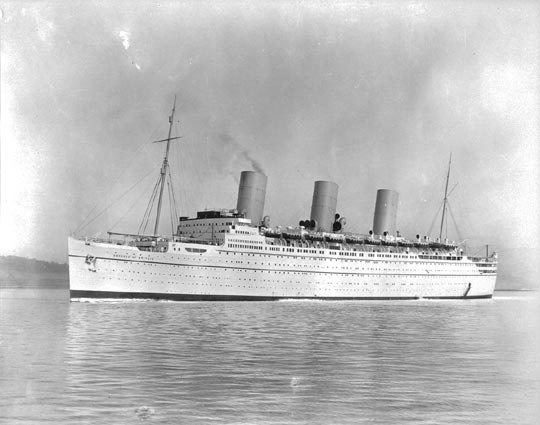
The RMS Empress of Britain, a majestic ocean liner of the early 20th century, met its tragic fate on October 28, 1940. While serving as a troopship during World War II, the vessel was torpedoed by a German U-boat off the coast of Ireland. The sinking of the Empress of Britain remains one of the most significant maritime disasters of any war.
The ship was en route from Liverpool, England, to Halifax, Nova Scotia, carrying nearly 2,000 passengers and crew, including military personnel, civilians, and refugees. In the darkness of the early morning hours, the U-32 fired two torpedoes at the Empress of Britain.
Despite efforts to save the ship, the Empress of Britain began to slowly sink. Within 30 minutes of being hit, the ship succumbed to the icy waters of the North Atlantic, sinking beneath the waves. 45 passengers and crew ended up perishing in the tragedy.
Sinking date: October 28, 1940
Deaths: 45
Survivors: 578
Maiden voyage: May 5, 1906
Length: 761 ft. (232 m)
Original capacity: ~800
SS Andrea Doria (1956)

The SS Andrea Doria was an Italian ocean liner that launched in 1951. It was considered a symbol of Italian national pride and post-war recovery.
On the night of July 25, 1956, while en route to New York City from Genoa, Italy, the Andrea Doria collided with the MS Stockholm, a Swedish ocean liner, in heavy fog off the coast of Nantucket, Massachusetts.
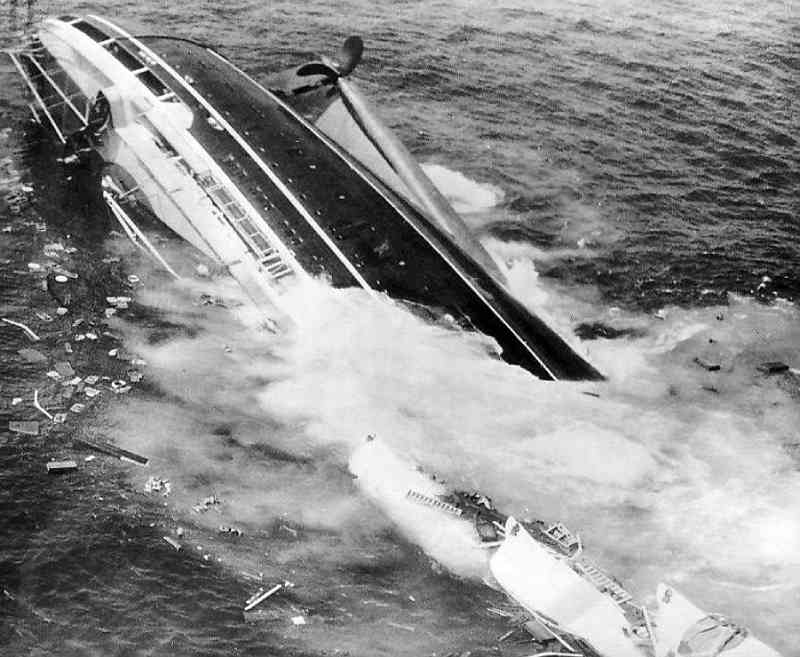
Despite having radar, the ships misinterpreted each other, leading to the catastrophic collision. The impact was devastating, tearing a huge hole in the side of the Andrea Doria and causing it to list severely to starboard.
Thanks to the efforts of the crew, nearby ships, and improved safety standards, nearly all of the Andrea Doria’s passengers and crew were saved. Unfortunately, the ship sank the following morning, about 11 hours after the collision.
Sinking date: July 26, 1956
Deaths: 51
Survivors: 753
Maiden voyage: January 14, 1953
Length: 701 ft. (214 m)
Original capacity: 1,241 passengers
Angelina Lauro (1979)

Angelina Lauro, previously known as the MS Oranje, was a Dutch passenger ship that served as a hospital ship during World War II and later as a cruise ship. Launched in 1939 and operated initially by the Netherlands Lines, it was requisitioned by the Australian government during the war.
Post-war, it resumed passenger service, and faced a notable collision in 1953, which severely damaged its bow. The ship was sold to Lauro Lines in 1965 and Costa Lines in 1977. In 1979, while docked in Saint Thomas, U.S. Virgin Islands, a fire led to its total loss. The ship later sank in the middle of a storm while being towed to a scrapyard.
Sinking date: September 24, 1979
Deaths: 0
Maiden voyage: 1939
Length: 656 ft. (200 m)
Original capacity: 740 passengers
MS Mikhail Lermontov (1986)

The MS Mikhail Lermontov, originally launched in 1972, was a Soviet ocean liner that was converted into a cruise ship. On the 16th of February, 1986, the MS Mikhail Lermontov had a tragic accident that led to its sinking.
While navigating the Marlborough Sounds in New Zealand, under the guidance of a local pilot, the ship struck rocks near Cape Jackson. The impact tore open the hull, and the MS Mikhail Lermontov sank within hours. At the time of the disaster, the cruise ship was carrying hundreds of passengers and crew on a cruise from Sydney, Australia, to New Zealand.
After the MS Mikhail Lermontov sank in 1986, both New Zealand and Soviet investigators looked into the accident and found that the pilot, Captain Don Jamison, was at fault. They pointed out that he chose a risky path that was too shallow. The investigators questioned his judgment, with a New Zealand official stating, “why he decided to guide the ship over a passage that he actually knew was too shallow, I don’t think he’ll ever be able to answer.”
Sinking date: February 16, 1986
Deaths: 1
Maiden voyage: May 28, 1973
Length: 578 ft. (155 m)
Original capacity: 1,334 passengers
MV Jupiter (1988)
The MV Jupiter was a Greek-registered cruise ship that tragically sank on October 21, 1988, just 40 minutes after leaving the port of Piraeus, Greece. This ship was originally launched on February 19, 1961, as Moledet, serving the Zim Israel Navigation Company Ltd before being sold to Epirotiki Line in September 1970 and renamed Jupiter.
On the fateful day, the Jupiter had 391 British schoolchildren and 84 adults on a study cruise, along with a crew of 110 on board. The disaster resulted in the deaths of one pupil, one teacher, and two Greek crew members. The sinking occurred after the Jupiter collided with the Italian freight ship Adige, which tore a hole in the ship, causing it to sink.
Sinking date: October 21, 1988
Deaths: 4
Maiden voyage: March 19, 1974
Length: 218 ft (66 m)
Original capacity: 531 passengers
MTS Oceanos (1991)
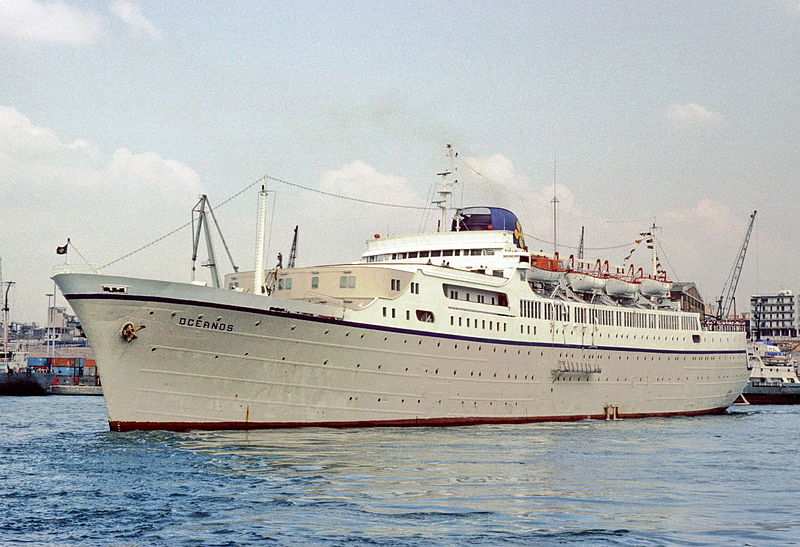
The MTS Oceanos was a Greek-owned cruise ship that was launched in 1952. On August 4, 1991, the ship became flooded and sank in severe weather off South Africa’s eastern coast.
The Oceanos set out from East London, South Africa, heading towards Durban, carrying 571 passengers and crew. The ship encountered rough seas and strong winds as it sailed along the Wild Coast. The disaster began to unfold when a leak in the engine room led to the failure of the power systems, leaving the ship without pumps to remove incoming water.
As the situation worsened, the ship’s captain abandoned the ship. This act of cowardice became one of the most talked-about aspects of the disaster. Fortunately, the entertainment staff, led by guitarist Moss Hills, took charge of the evacuation, proving instrumental in coordinating the rescue efforts. They used the ship’s radio to make distress calls, which were answered by nearby ships and helicopters.
The rescue operation was remarkable for its success under adverse conditions. All 571 people on board were saved, with no loss of life, thanks to the efforts of the South African Air Force and a Dutch cargo ship.
Sinking date: August 4, 1991
Deaths: 0
Survivors: 571
Maiden voyage: 1953
Length: 502 ft. (153 m)
Original capacity: 550 passengers
MS Achille Lauro (1994)

The MS Achille Lauro was an Italian ocean liner most notorious for its hijacking by the Palestine Liberation Front in 1985. The ship met a tragic end when it sank in 1994 in the Indian Ocean. Originally built in 1947 as the MS Willem Ruys by the Royal Rotterdam Lloyd, it was named after Achille Lauro, an Italian businessman and politician, when it was purchased by the Lauro Line in 1965. The ship had an eventful career, serving as both a passenger liner and a cruise ship, traveling to many destinations around the world.
The end of the MS Achille Lauro came on November 30, 1994, while it was sailing off the coast of Somalia in the Indian Ocean. A fire broke out in the engine room and spread throughout the ship. Following the evacuation, the fire continued to rage uncontrollably, and the ship eventually succumbed to the damage.
The MS Achille Lauro eventually sank on December 2, 1994. Thankfully, most of the passengers and crew were evacuated safely, though the tragedy resulted in the loss of two lives.
Sinking date: December 2, 1994
Deaths: 2
Maiden voyage: December 2, 1947
Length: 630 ft. (192 m)
Original capacity: 900 passengers
Sun Vista (1999)

The Sun Vista, originally an ocean liner named the SS Galileo Galilei, was a cruise ship that met its fate on May 20, 1999. The ship was in the Strait of Malacca, near Malaysia, when a fire broke out in the engine room. Despite efforts to control the fire, it spread rapidly throughout the ship.
The evacuation process involved more than 1,000 passengers and crew members, who had to abandon the ship and were rescued by lifeboats. The operation was carried out under challenging conditions but, fortunately, resulted in no loss of life.
Following the evacuation, the Sun Vista eventually sank in the early hours of May 21, 1999. The sinking of the Sun Vista was a significant loss in the cruise industry, marking the end of a ship that had served for almost 40 years.
Sinking date: March 23, 1963
Deaths: 0
Survivors: 1,090
Maiden voyage: May 21, 1999
Length: 702 ft. (214 m)
Original capacity: 1,750 passengers
MS World Discoverer (2000)

The MS World Discoverer was a small cruise ship designed for navigating through polar waters, offering its passengers the unique experience of exploring some of the most remote areas of the world. Built in 1974 by Schichau Unterweser in Bremerhaven, West Germany, the ship was initially named BEWA Discoverer and was later renamed World Discoverer to reflect its mission of global exploration. The ship had a double hull, so it could safely navigate through ice-packed regions.
On April 30, 2000, the World Discoverer struck an uncharted reef in the Sandfly Passage, a narrow stretch of water in the Solomon Islands. The impact caused severe damage to the ship’s hull, leading to the immediate risk of sinking. The captain managed to beach the vessel nearby reef to prevent it from completely sinking and helped evacuate the passengers and crew.
Following the partial sinking, the MS World Discoverer became a subject of salvage operations. However, due to the remote location and the difficulty in accessing the wreck, the ship was never fully salvaged and remains stranded at Roderick Bay of the Nggela Islands, with a 46 degree tilt.
Sinking date: April 30, 2000
Deaths: 0
Maiden voyage: 1973
Length: 289 ft. (88 m)
Original capacity: 137 passengers
MS Sea Diamond (2007)

The MS Sea Diamond was a cruise ship that sank off the coast of Santorini, Greece, in April 2007, leading to the deaths of 2 people. The incident occurred when the ship struck a reef and began taking on water. Despite efforts to control the flooding, the ship was evacuated within hours of the collision. The evacuation process, although chaotic, was largely successful, with most passengers and crew being safely transferred to rescue boats and taken to the island.
Two passengers, a Frenchman and his daughter, were reported missing and later presumed dead, marking a somber note in the otherwise successful evacuation effort. The loss of lives cast a shadow over the incident and led to questions about the ship’s safety procedures. The Greek authorities later launched an investigation into the causes of the sinking.
The sinking of the MS Sea Diamond caused severe environmental pollution. The ship contained large quantities of fuel and hazardous materials, posing a serious threat to marine life in the area. There were some efforts to contain and mitigate the environmental impact, though it’s not certain how effective they were.
Sinking date: April 5, 2007
Deaths: 2
Survivors: Over 1,590
Maiden voyage: April 22, 1986
Length: 469 ft. (143 m)
Original capacity: 1,537 passengers
MV Explorer (2007)
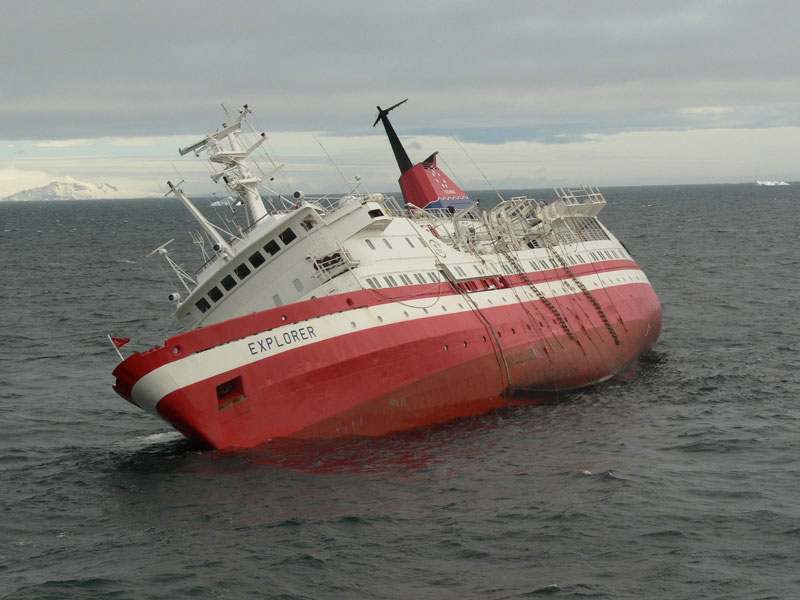
The MV Explorer, a Liberian-registered cruise ship built in 1969, gained infamy for its sinking in 2007 under dramatic circumstances. This vessel wasn’t an ordinary cruise ship; it was specifically designed for educational voyages in the Antarctic Ocean.
On November 23, 2007, the MV Explorer encountered trouble in the Bransfield Strait near the South Shetland Islands. The ship struck an iceberg, causing a fist-sized hole in the hull and leading to rapid flooding and the sinking of the ship. Despite the crew’s efforts to manage the situation, the damage was irreparable, and the decision was made to abandon ship. Remarkably, all the passengers, crew, and guides were saved. They waited for hours in the lifeboats until they were rescued by the Norwegian cruise ship MS Nordnorge.
The sinking of the MV Explorer serves as a stark reminder of the unpredictable nature of sea travel, especially in the perilous and icy waters of the Antarctic. The Liberian Bureau of Maritime Affairs carried an investigation into the sinking in 2009. The report found that there might have been an underestimation of the risks posed by icebergs in the vessel’s path.
Sinking date: November 23, 2007
Deaths: 0
Survivors: 154
Maiden voyage: 1969
Length: 239 ft. (73 m)
Original capacity: 104 passengers
Costa Concordia (2012)
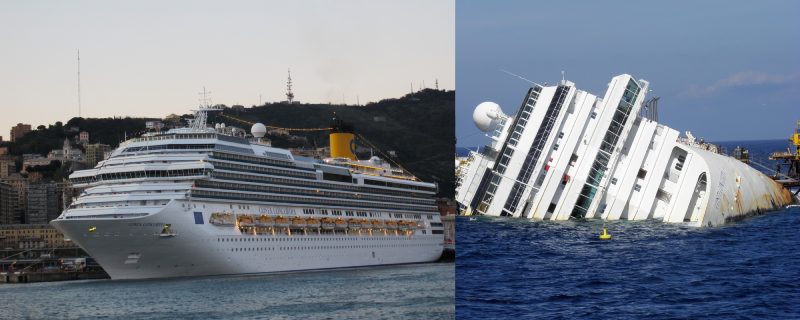
Perhaps the most well-known modern day maritime disaster is the partial sinking of the Costa Concordia. The large cruise ship struck a rock off the coast of Isola del Giglio, Italy, during a maneuver close to the island. This resulted in a large, 160 ft. (50 m) gash in its hull. The Costa Concordia then began to take on water and eventually tilted on its side, leading to a chaotic and panicked evacuation process.
The disaster resulted in the deaths of 32 people, who lost their lives due to various causes, including drowning and injuries sustained during the evacuation. Despite the tragic loss of life, there were many survivors, with over 4,200 people managing to escape the sinking ship. This included passengers from around the world and crew members, who faced harrowing conditions as they sought to flee the tilting vessel.

The captain of the Costa Concordia, Francesco Schettino, was heavily criticized for his actions during and after the collision. He was accused of bringing the ship too close to the shore in a maneuver known as a “salute,” and then abandoning the ship before ensuring that all passengers and crew were safely evacuated. His actions led to criminal charges, including manslaughter.
The ship remained partially submerged off the coast of Giglio for more than two years before a complex salvage operation successfully re-floated the ship so it could be towed away for scrapping.
Sinking date: January 13, 2012
Deaths: 32
Survivors: Over 4,200
Maiden voyage: July 14, 2006
Length: 951 ft. (290 m)
Original capacity: 3,700 passengers
Oriental Star (2015)
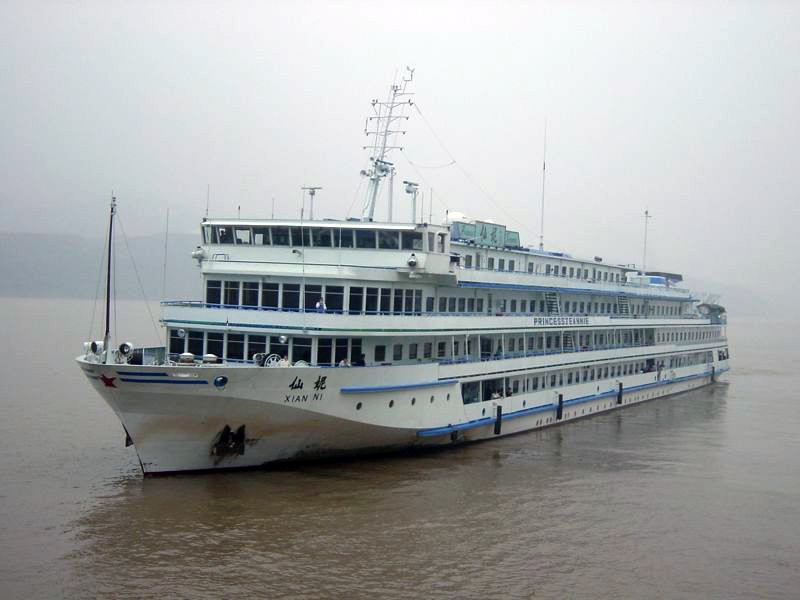
Photo by davidd, Wikimedia Commons
The sinking of the Oriental Star, also known as the Eastern Star, remains one of the most tragic cruise ship sinkings in recent times. On the evening of June 1, 2015, the Oriental Star was cruising through the waters of the Yangtze River in China when disaster struck.
As the cruise ship navigated the Yangtze River, it encountered a severe storm, including torrential rain and strong winds. These extreme weather conditions caused the ship to capsize suddenly, catching its passengers and crew off guard.
The Oriental Star, which was carrying 456 people onboard, mostly elderly tourists, was overwhelmed by the force of the storm. Within minutes, the ship had turned completely on its side, leaving only a small portion of its hull visible above the water. At the time of the sinking, most of the crew and passengers were asleep. Rescue efforts were immediately launched, with emergency responders and local authorities trying their best to save as many lives as possible.
Tragically, the majority of those onboard the Oriental Star did not survive the disaster. Only 12 passengers and crew members were rescued in the hours and days following the sinking. The final death toll numbered 442, making it one of the deadliest cruise ship sinkings in history.
After the sinking, Chinese authorities launched an investigation to find the cause and see if anyone was at fault. In the end 43 people were punished, though the Chinese media heavily censored the event so many details are unknown.
Sinking date: June 1, 2015
Deaths: 442
Survivors: 12
Maiden voyage: February 1994
Length: 251 ft. (76.5 m)
Original capacity: 534 passengers
Orient Queen (2020)
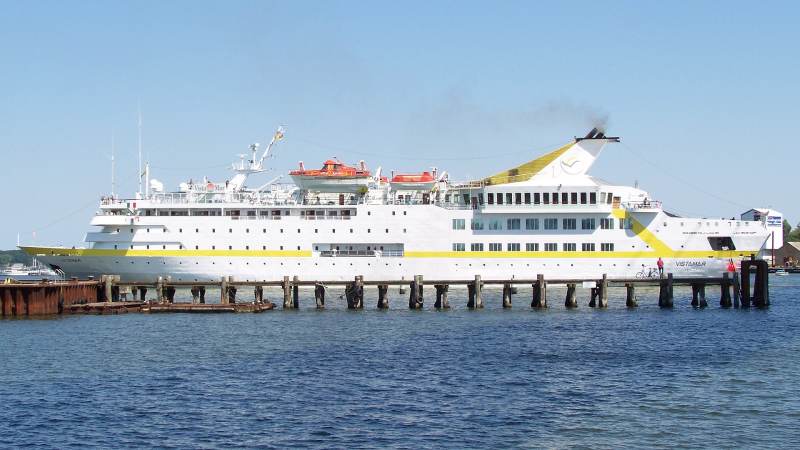
The Orient Queen was a cruise ship owned by Abou Merhi Cruises, under which it sailed primarily in the Eastern Mediterranean. The tragic sinking of the Orient Queen occurred in August 2020, as a direct consequence of the massive explosion in the port of Beirut.
On the 4th of August, a large quantity of ammonium nitrate stored at the port detonated, resulting in one of the most powerful non-nuclear explosions in history. The blast caused widespread damage throughout the city of Beirut, killing over 200 people, injuring thousands, and causing extensive property damage.
The Orient Queen, which was moored in the port of Beirut at the time of the explosion, suffered severe damage due to the shockwave and the subsequent flooding. The impact of the explosion was so significant that it led to the ship partially sinking. The event resulted in the loss of two lives among the crew members aboard the ship. The explosion also damaged other ships nearby..
Sinking date: June 27, 2020
Deaths: 2
Maiden voyage: 1989
Length: 423 ft. (129 m)
Original capacity: 300 passengers
How Many Cruise Ships Have Sunk? – FAQ
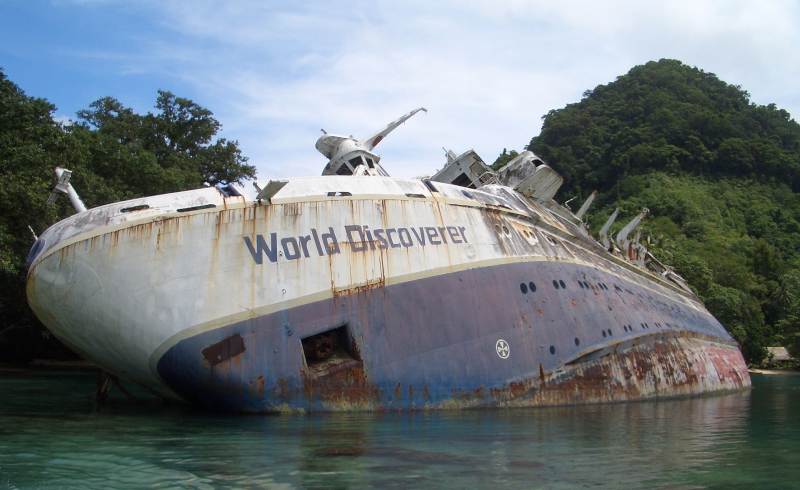
Photo by Philjones828, Wikimedia Commons
When was the last time a cruise ship sank?
The last recorded sinking of a cruise ship was the Orient Queen in 2020. The ship sank as a result of the massive explosion that occurred in the port of Beirut, Lebanon, on August 4, 2020. This tragic event was caused by the detonation of a large quantity of ammonium nitrate stored at the port.
The blast was so powerful that it caused significant damage across a large portion of the city, including the port area where the Orient Queen was docked. The force of the explosion inflicted critical damage to the vessel, ultimately leading to its sinking.
What are the odds of a cruise ship sinking?
The odds of a cruise ship sinking are approximately 1 in 273,000, or about 0.00037%, indicating an extremely low probability. This calculation is based on the assumption of 300 cruise ships each conducting 50 sailings annually over the last 50 years, with only 11 ships sinking during this period.
Despite the significant number of sailings—amounting to 750,000 over half a century—the safety record of cruise travel remains exceptional, emphasizing the rarity of such incidents amidst the millions of passenger experiences.

Why don’t cruise ships sink?
Cruise ships are designed with buoyancy and stability in mind, allowing them to float despite their massive size. This is primarily due to their hulls, which are large and hollow, creating a displacement effect that pushes water away, ensuring that the weight of the water displaced is equal to or greater than the weight of the ship. This principle, known as Archimedes’ principle, is key to keeping ships afloat.
Additionally, cruise ships are compartmentalized into watertight sections, which can be sealed off in the event of a breach in the hull, preventing water from filling the entire ship and maintaining buoyancy. Modern cruise ships also incorporate advanced stability technologies and are meticulously designed and tested to ensure they remain upright and stable, even in rough seas.

What was the largest cruise ship that sank?
The Costa Concordia is considered the largest cruise ship to have capsized and sunk. This tragic event occurred on January 13, 2012, when the ship struck a reef off the coast of Isola del Giglio, Italy, leading to a significant breach in its hull. The ship eventually partially sank near the island’s shore. At the time of the incident, the Costa Concordia was among the largest cruise ships in operation, measuring about 114,500 gross tons, with a length of 952 feet (290.20 meters) and a capacity to carry 4,232 passengers and crew.
Final Words
Cruise ship sinkings are very rare, especially considering the vast number of ships that sail the world’s oceans every year.
The cruise industry has seen significant advancements in technology and the implementation of strict safety protocols. These measures, coupled with international regulations, contribute to making cruising a safe form of travel.
Modern ships are equipped with state-of-the-art navigation systems, emergency response procedures, and construction standards that exceed what was available in the past. So these days, the chance of your cruise ship sinking is extremely low.
